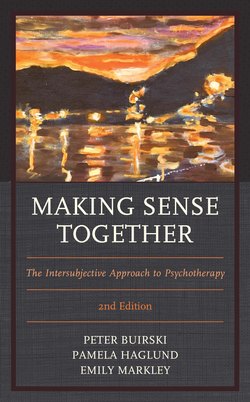Making Sense Together

Реклама. ООО «ЛитРес», ИНН: 7719571260.
Оглавление
Peter Buirski. Making Sense Together
Foreword
Preface. First Edition
Second Edition
Acknowledgments. First Edition
Second Edition
Introduction to the 1st Edition
Overview
Subjectivity and Intersubjectivity
Domain of Inquiry
Treatment Aims
Investigatory Stance
Summary
The Intersubjective Sensibility
Summary
Understanding the Patient’s. State of Mind
Affect Responsiveness in Intersubjectivity Theory
The Empathic-Introspective Stance and Intersubjectivity Theory
Summary
The Centrality of Relationship
Summary
Practicing Intersubjectively
Summary
The Articulation of. Subjective Experience
Clinical Material
Discussion
Summary
The Antidote Dimension of the Therapy Relationship
Clinical Material
Summary
Listening and Responding Intersubjectively
Identifying Organizing Principles
Metaphors
Springboard to the Past
Charged Words
Ask for Examples
Don’t Change the Subject
Be a Witness to Mistreatment, Abuse, or Trauma
A Note on Caregiver Blaming
Summary
Co-constructing a. Developmental Narrative
Being Present in the Moment
Doing Is the Enemy of Understanding
Exploring the Underlying Meaning of Questions
Treating the Whole Person
Sympathy Is Not Empathy
Depathologizing
Developing One’s Voice and Sense of Pride
Summary
Expanding the Field
Summary
The Treatment of a Patient from the Intersubjective Perspective
Clinical Material
Conclusion
References
Index
About the Authors
Отрывок из книги
This book is intended for students of the psychotherapeutic process and particularly those interested in the intersubjective perspective. In our own professional development, we have followed many paths that have led us to the point of writing this book. We have been patients in psychotherapy and psychoanalysis, graduates of psychoanalytic training institutes, and teachers of psychoanalytic theory and practice to graduate psychology students and candidates in analytic training.
We were both first exposed to psychoanalytic theory and treatment from the perspective of ego psychology. Over the years, our thinking and practice have evolved. We have found that arriving at a theory of practice has been an ongoing, long-term evolutionary process. Like being a patient in psychotherapy, becoming a psychotherapist is a highly personal experience of deepening self-awareness. There are times of anxiety, dread, and self-doubt, as well as times of hope, confidence, and joy in the mutuality of the endeavor. Growth occurs slowly, incrementally, and imperceptibly, over long periods of time.
.....
According to Stolorow and colleagues (1987), “The fundamental goal of psychoanalytic therapy is the unfolding, illumination, and transformation of the patient’s subjective world” (p. 9). To approach this goal, the therapist who operates with an awareness of the intersubjective nature of psychological processes must provide an environment in which the patient’s world of subjective experience is able to unfold. This environment includes the ambiance of the setting, the empathic-introspective listening stance of the therapist, and the relationship created between the two of them. In addition to these factors, many unforeseen elements arising from the histories and the organization of experience of each participant contribute to the context. “Analyst and patient form an indissoluble psychological system, and . . . neither can, without violence to the integrity of the analytic experience, be studied alone” (Orange et al. 1997, p. 76). During the course of treatment, the attuned therapist explores and draws attention to the impact of these subtleties on the treatment. Essentially, the patient and therapist together create the environment in which a therapeutic dialogue can occur. It is through this dialogue that the patient’s story will unfold.
A second task of the intersubjective approach to therapy is to illuminate, to shed new light on, the patient’s subjective experience and the personal meanings the patient has made of it. Intersubjectivity theory draws heavily on the hermeneutic tradition (Atwood & Stolorow 1984). Hermeneutics originally referred to the theory of interpretation of religious texts. It has subsequently been applied to the interpretation and understanding of human subjectivity. When we investigate human subjectivity, our focus is on personal meanings. Man is a meaning maker, and humans create meaning out of their subjective experience. Meanings made of today’s experience influence the meaning made of subsequent experience. Therefore, we must expand our domain of inquiry to include not just subjective experience but also the meaning each person makes of her subjective experience and the impact of that meaning on further experience.
.....